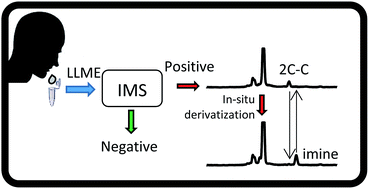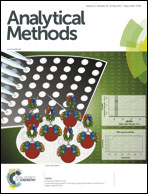In situ derivatization for double confirmation of 2C–C in oral fluids by ion mobility spectrometry
Abstract
Ion mobility spectrometry (IMS) is a powerful tool to carry out quick and sensitive detection of illicit activities and has been employed for the determination of the psychedelic drug 2,5-dimethoxy-4 chlorophenethylamine (2C–C) in oral fluid samples. Saliva samples were extracted with chloroform and analysed by IMS reaching a limit of detection (LOD) of 14 μg L−1. Nevertheless, IMS has a scarce resolution and selectivity of the method can be often compromised by the presence of potential interferents with similar molecular weights and drift times. Thus, a rapid and in situ derivatization with acetone, to form the corresponding imine, has been proposed in the present study to confirm the presence and concentration of 2C–C. The proposed strategy, based on the double IMS confirmation, was applied to the analysis of 2C–C in the presence of naphazoline and amfepramone drugs, avoiding the drift time interference and allowing an accurate estimation of 2C–C content in oral fluids. The method was validated in terms of sensitivity, trueness and precision using spiked samples and method comparison, reaching a limit of detection of 10 μg L−1 for the 2C–C derivative product. So, the proposed in situ derivatization approach can be employed for the analysis of primary amine-based drugs by IMS for the routine control of drugs in official laboratories.



 Please wait while we load your content...
Please wait while we load your content...